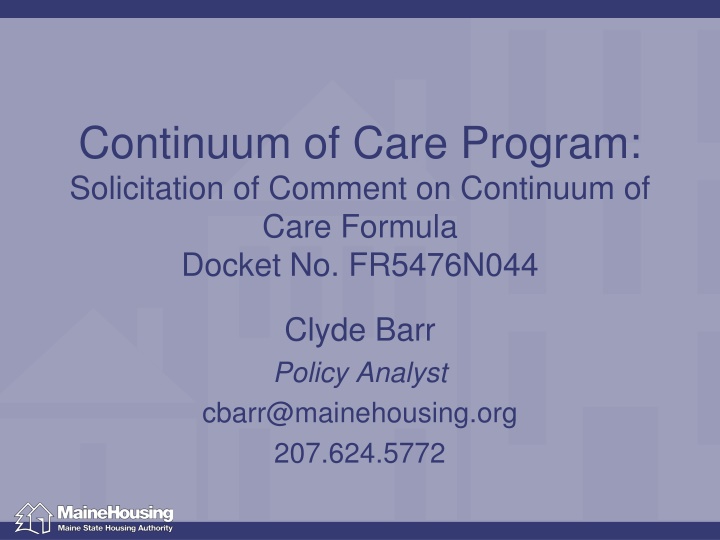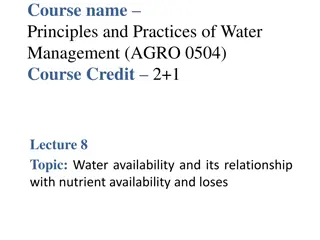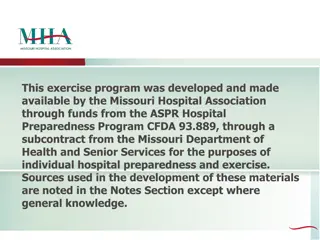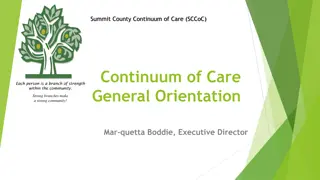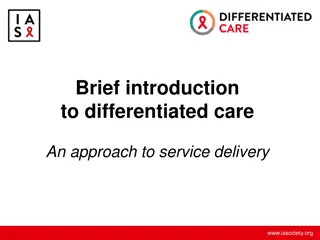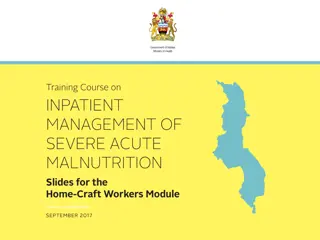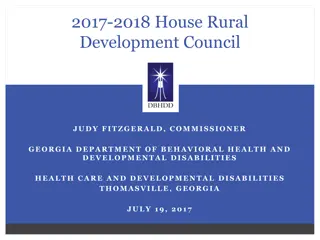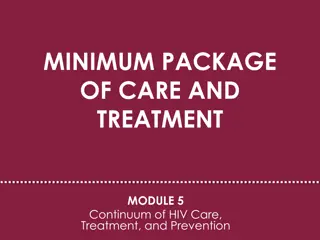Continuum of Care Program:
The Continuum of Care program is soliciting comments on the formula used to award grant funds for homelessness programs. Previous feedback highlighted concerns about representation, appropriateness of formulas, and reliance on urban blight. HUD aims to develop new formulas to better reflect homeless needs in communities by incorporating relevant, accurate, and timely data sources. Proposed formulas include factors such as population, poverty, affordability gap, rent-burdened households, and rental units.
Download Presentation

Please find below an Image/Link to download the presentation.
The content on the website is provided AS IS for your information and personal use only. It may not be sold, licensed, or shared on other websites without obtaining consent from the author.If you encounter any issues during the download, it is possible that the publisher has removed the file from their server.
You are allowed to download the files provided on this website for personal or commercial use, subject to the condition that they are used lawfully. All files are the property of their respective owners.
The content on the website is provided AS IS for your information and personal use only. It may not be sold, licensed, or shared on other websites without obtaining consent from the author.
E N D
Presentation Transcript
Continuum of Care Program: Solicitation of Comment on Continuum of Care Formula Docket No. FR5476N044 Clyde Barr Policy Analyst cbarr@mainehousing.org 207.624.5772
Current PPRN Calculation Combination of The formula used to award ESG program grant funds and CDBG funds Current CDBG dual formula system: Larger of the two calculations assigned, less a pro rata reduction* *ensures the total amount allocated is within the amount appropriated for funding
Previous Comments Not representative of the number of individuals & families experiencing homelessness in their geographic area CDBG formula was not appropriate for PPRN Disliked the reliance on urban blight as reflected in the age of the housing stock predominantly from western States, counties, and cities Opposed to reductions for renewal projects
Developing New PPRN Formulas HUD sought to maintain the basic structure Data sources need to be: 1. Relevant 2. Accurate 3. Timely 4. Readily available Chose not to incorporate PIT directly Used average of two years
Overview of Proposed Formulas Goal: to approximate the actual homeless need in communities Diminished reliance on annual PIT Pre 1940s housing & Overcrowding not included
Overview of Proposed Formulas Formula A 10% * population Formula B 25% * poverty Formula C 25% * population Formula D 25% * poverty 15% * poverty 25% * affordability gap 25% * poverty 25% * affordability gap 25% * affordability gap 50% * hybrid factor 25% * rent- burdened ELI households 50% * hybrid factor 25% * rent- burdened ELI households 25% * rental units 25% * rental units
Alt Formula A Baseline Allocation COCNUM COCNAME PPRN15 Alt Formula $ Diff PCT Diff Maine Balance of State CoC ME-500 $3,712,281 $4,157,086 $4,288,146 $575,865 15.51% ME-502 Portland CoC $1,222,088 $1,884,953 $624,340-$597,748 -48.91% ME-5** FORMULA WEIGHTS 10% * population 15% * poverty 25% * affordability gap 25% * rent-burdened ELI Households 25% * rental units 34% of CoCs funding could decrease between $307 - $25,955,807 One Maine CoC $4,934,369 $6,042,039 $4,778,650-$155,719 PEARSON S CORRELATION No significant correlation .153 .310 .336 .444 -3.16%
Alt Formula B Baseline Allocation COCNUM COCNAME PPRN15 Alt Formula $ Diff PCT Diff Maine Balance of State CoC ME-500 $3,712,281 $4,157,086 $4,205,686 $493,405 13.29% ME-502 Portland CoC $1,222,088 $1,884,953 $631,500 -$590,588 -48.33% ME-5** FORMULA WEIGHTS 25% * poverty 25% * affordability gap 25% * rent-burdened ELI Households 25% * rental units One Maine CoC $4,934,369 $6,042,039 $4,703,350 -$231,019 PEARSON S CORRELATION .153 .310 .336 .444 -4.68% 35% of CoCs funding could decrease between $646 - $25,410,952
Alt Formula C Baseline Allocation COCNUM COCNAME PPRN15 Alt Formula $ Diff PCT Diff Maine Balance of State CoC ME-500 $3,712,281 $4,157,086 $4,254,856 $542,575 14.62% ME-502 Portland CoC $1,222,088 $1,884,953 $612,211-$609,877 -49.90% ME-5** FORMULA WEIGHTS 25% * population 25% * poverty 50% * hybrid One Maine CoC $4,934,369 $6,042,039 $4,536,819-$397,550 PEARSON S CORRELATION No significant correlation .153 .393 -8.06% 37% of CoCs funding could decrease between $406 - $25,701,362
Alt Formula D Baseline Allocation COCNUM COCNAME PPRN15 Alt Formula $ Diff PCT Diff Maine Balance of State CoC ME-500 $3,712,281 $4,157,086 $3,795,378 $83,097 2.24% ME-502 Portland CoC $1,222,088 $1,884,953 $701,758-$520,330 -42.58% ME-5** FORMULA WEIGHTS 25% * poverty 25% * affordability gap 50% * hybrid factor One Maine CoC $4,934,369 $6,042,039 $4,166,388-$767,981 -15.56% PEARSON S CORRELATION .153 .310 .393 37% of CoCs funding could decrease between $8,279 - $22,436,373
A Deeper Look. . . 100 Largest PIT 38% - 44% of CoCs see decreased funding Mean PIT: 4,075 Median PIT: 2,165 100 Smallest PIT 23% - 26% of CoCs see decreased funding Mean PIT: 189 Median PIT: 185
Big Picture of Alt Formulas % Negative Funding by Census Regions Region Alt A Alt B National 34% 35% New England 54% 54% Mid-Atlantic 65% 70% Midwest ENC 42% 44% Midwest WNC 35% 35% South Atlantic 22% 22% East South 13% 13% West South 15% 15% Mountain 11% 11% Pacific 24% 24% Alt C 37% 50% 67% 45% 39% 25% 13% 18% 28% 29% Alt D 37% 54% 74% 44% 42% 28% 13% 18% 17% 24%
Custom Calculation Baseline Allocation COCNUM COCNAME PPRN15 Alt Formula $ Diff PCT Diff Maine Balance of State CoC ME-500 $3,712,281 $4,157,086 $5,194,189 $1,481,908 39.92% ME-502 Portland CoC $1,222,088 $1,884,953 $841,561 -$380,527 -31.14% ME-5** FORMULA WEIGHTS 15% * poverty 15% * pre-1940 housing 20% * affordability gap 50% * hybrid One Maine CoC $4,934,369 $6,042,039 $5,705,002 PEARSON S CORRELATION .153 .113 .310 .393 $770,633 15.62% 37% of CoCs funding could decrease between $8,531 - $18,982,831
% Difference Maine Alt Formulas Alt A Alt B Alt C Alt D Custom COCNUM PPRN15 ME-500 ME-502 ME-5** $3,712,281 $1,222,088 $4,934,369 15.51% -48.91% -3.16% 13.29% -48.33% -4.68% 14.62% -49.90% -8.06% 2.24% -42.58% -15.56% 39.92% -31.14% 15.62% Including pre-1940s housing has a positive impact in the northeast and a negative impact in the west and south Atlantic
Alt Formulas vs. Custom % Negative Funding by Census Regions Region Custom 37% 39% 54% 43% 39% 40% 13% 24% 28% 29% Alt A 34% 54% 65% 42% 35% 22% 13% 15% 11% 24% Alt B 35% 54% 70% 44% 35% 22% 13% 15% 11% 24% Alt C 37% 50% 67% 45% 39% 25% 13% 18% 28% 29% Alt D 37% 54% 74% 44% 42% 28% 13% 18% 17% 24% National New England Mid-Atlantic Midwest ENC Midwest WNC South Atlantic East South West South Mountain Pacific
HUD wants to know our thoughts:
Thoughts on. . . THE FOUR PROPOSED FORMULA OPTIONS More than 1/3 of CoCs could see funding decrease with all proposed funding formulas New England & Mid-Atlantic states are disproportionately affected
Thoughts on. . . FACTORS AND CORRESPONDING WEIGHTS Including pre-1940s housing increases funding in the Models with the hybrid factor have the most CoCs that could lose funding There is not a one size fit all
Thoughts on. . . DUAL OR MULTI-FORMULA SYSTEM Support a dual or multi-formula system Regional differences should be accounted in funding system Pre-1940s housing Variable s impact will decrease with time
Thoughts on. . . LANGUAGE THAT WOULD PREVENT A COC FROM LOSING MORE THAN A CERTAIN PORTION OF THEIR PPRN YES HUD should adopt language that would prevent a CoC from losing more than X% of its funding
Thoughts on. . . OTHER COMMENTS ON COC FORMULAS OTHER COMMENTS ON COC FORMULAS ESG 75/25 split should be discontinued 75/25 ESG Entitled/Non-entitled Split Alt A MCoC -35% PCoC -32% PCoC -32% ESG 75/25 split should be discontinued 75/25 ESG Entitled/Non-entitled Split Alt A MCoC -35% Alt B -36% -32% -32% Alt C -36% -36% -36% Alt D -38% -28% -28% Alt B -36% Alt C -36% Alt D -38%
Thoughts on. . . OTHER COMMENTS ON COC FORMULAS Declining importance of annual PIT a good idea Hypothesis, including more robust count data from new HUD Performance Metric 3 (number of homeless persons) could: Smooth out funding discrepancies Provide a truer picture of need
